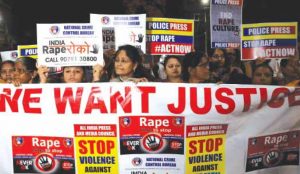 Justice has prevailed after a long and constant legal battle in the most-awaited Nirbhaya rape and murder case. All the four convicts were executed on March 20. With this, after an extensive wait of seven years, justice has finally been delivered to the 23-year-old physiotherapy intern who was savagely brutalised in an empty moving bus in a South Delhi neighbourhood. With numerous loopholes in our legal system, the long fight of the two brave women Nirbhaya’s mother Asha Devi and lawyer Seema Kushwaha has been won.
Justice has prevailed after a long and constant legal battle in the most-awaited Nirbhaya rape and murder case. All the four convicts were executed on March 20. With this, after an extensive wait of seven years, justice has finally been delivered to the 23-year-old physiotherapy intern who was savagely brutalised in an empty moving bus in a South Delhi neighbourhood. With numerous loopholes in our legal system, the long fight of the two brave women Nirbhaya’s mother Asha Devi and lawyer Seema Kushwaha has been won.
Union Law Minister Ravi Shankar Prasad said, “It’s a day of satisfaction that a daughter, who underwent so much pain, has got justice,” Prasad told reporters in Parliament. “It’s time for judiciary, government and civil society to introspect whether death-row convicts can be allowed to manipulate system and cause delay.”
The hanging of the four convicts- Mukesh Singh (32), Pawan Gupta (25), Vinay Sharma (26) and Akshay Kumar Singh (31) was carried out at 5:30 in Tihar Jail. A hanging was carried out as per the schedule after a three- judge Supreme Court bench rejected the final plea by the convict’s lawyer. With the execution of death penalty of Nirbhaya case convicts a sense of relief can be felt across the country but the state of pending cases of rape across the country tells a different story. Around 2.45 lakhs Nirbhaya’s are there who are still waiting for justice.
After the Supreme Court’s verdict, the mother of the young woman Asha Devi said — “We all have waited so long for this day. Today is a new dawn for daughters of India. The beasts have been hanged,” she went home and hugged her daughter’s photo.
With the hanging of the four convicts, Nirbhaya got justice but what about so many other Nirbhayas in the country who are still waiting for justice. Reason, since decades, Indian legal system is facing huge backlog of such cases. The experts say that the number of such pending cases are alarming and raise concern for the government as well as for the judicial system of the country.
The government has revealed a shocking statistic of large number of pending rape and POCSO (Prevention of Children from sexual offences) cases in various courts across India. According to the government data there are total 2,44,001 pending rape and POCSO cases in India as on December 2019. Uttar Pradesh is at the top of the list having 66,994 outstanding cases while Maharashtra has total 21691 pending cases, whereas 20511 cases are pending in West Bengal. Madhya Pradesh has 19981 cases. Rajasthan holds the count of 11,159 cases. The number of pending cases raise a question mark on government’s ambitious “Beti Bachao, Beti Padhao” campaign?
NCRB data further suggests — each fourth rape victim across the country in 2018 was a minor, while more than 50 per cent of them fell in the age category of 18 to 30 years. The statistics released on January 9, 2020 highlight the poor state of law and order situation throughout the country with 378,277 cases of crime reported against women in 2018. The data showed Uttar Pradesh having the most number of cases relating to crimes against women at 59,445. Madhya Pradesh has a dubious distinction with maximum number of rape cases at 5,450- nearly 15 rape cases a day. On the other hand, Delhi has become the most dangerous capital for women in the world. Witness the highest 1,217 number of rapes in 2018.
While talking on the issue of pendency of rape & POSCO cases Chairperson of National Commission for Women, Rekha Sharma, said- “We have robust laws but implications need to be better. Plus long complicated legal procedures need to be changed and fast courts are must”
As per the data of NCRB in 94 per cent of the cases the criminals were known to the victims. In as many as 18,059 cases the rapists were friends, employers, neighbors or other known persons, while in 11,945 cases they were online friends. The figure is almost the same for 2017, when the victims knew 93.1 per cent of the rapists.
Overall, 72.2 per cent of rape victims were above 18 years and 27.8 per cent below 18, the data stated. In 2018, 51.9 per cent rape victims (17,636) were aged between 18 and 30 years, 18 per cent (6,108) above 30 and below 45 years, 2.1 per cent (727) above 45 and below 60 years and 0.2 per cent (73) above 60 years, it showed.
The data further suggests, 14.1 per cent rape victims (4,779) were aged above 16 years and below 18 years, followed by 10.6 per cent (3,616) who were between 12 and 16 years, 2.2 per cent (757) who were between 6 years and 12 years and 0.8 per cent (281) were below 6 years. In 2,780 cases, their own family members despoiled the victims, according to the figures.
Moreover, the number of rape cases has been twice in last 17 years. On average, 67 women were raped daily across the country throughout these 17 years, or about three women had been raped every hour. In the year 2001 the number of registered rape cases were 16,075 across India, this number rose hugely to 32,559 by 2017.
The NCRB, under the Union ministry of home affairs, is responsible for collecting and analysing crime data as defined by the Indian Penal Code and special and local laws in the country.
Meanwhile, according to a survey of Thompson Reuters Foundation, India ranks as world’s most dangerous country for women. Due to the rising statics of rape cases and high risk of sexual violence India has become the most unsafe nation around the globe, while Afghanistan is at second position and Syria ranks third.
To deal with the situation, Minister of Law and Justice, Ravi Shankar Prasad informed that Government has launched a Centrally Sponsored Scheme for setting up of a total of 1023 State wise Fast Track Special Courts (FTSCs) across the country for expeditious trial and disposal of pending cases pertaining to rape and POCSO Act, 2012.
Out of 1,023 State wise Fast Track Special Courts (FTSCs), 218 courts were proposed to be set in Uttar Pradesh, 138 in Maharashtra, 123 in West Bengal, 67 in Madhya Pradesh, 56 in Kerala, 54 in Bihar, 45 in Odisha & Rajasthan respectively. 36 in Telangana, 35 in Gujarat, 31 in Karnataka, 27 in Assam, 22 in Jharkhand,18 in Andhra Pradesh,16 in Haryana and in NCT of Delhi respectively, 15 in Chhattisgarh, 14 in Tamil Nadu, 12 in Punjab, 06 in Himachal Pradesh, 05 in Meghalaya, 04in Jammu & Kashmir and Uttarakhand, 03in Arunachal Pradesh, Mizoram and Tripura, 02 in Goa and Manipur,01in Chandigarh, Nagaland and Andaman and Nicobar Island. Moreover, An amount of 99.43 crore has also been approved by the government to release to set up 649 Fast track special court in India during 2019-20 to 27 states and union territories.
Among 195 Fast Track Special Courts functional and established for Women and Girl children under the Scheme of FTSCs till January 2020, 56 are in Madhya Pradesh, 34 in Gujarat, 26 in Rajasthan, 22 in Jharkhand, 16 in Delhi, 15 are in Chhattisgarh, 03 in Tripura, 09 in Telangana, and 14 in Tamil Nadu.
Despite courts disposing huge number of cases every year, pending cases keep rising. One of the prime reasons why we are not able to contain the ever-growing pendency is shortage of High Court judges. To speed up disposal of pending cases for over 10 years Nyaya Mitra Scheme launched in 2017. Under this scheme retired judicial officers were appointed to assist the district judiciary in reduction of pendency of ten years old cases and increasing access to justice for marginalized people.
As on July 2019, 399 posts, or 37 per cent of sanctioned judge-strength, are vacant. Court is expected to dispose 165 pending cases annually to overcome this delay.
Sexual Violence and rapes has become a subject of debates over news channels and burning conversations and that is a big deal in a country where sex and sexual crimes are a prohibited. The question arises if movements like #metoo, street protests, candle marches or tougher laws to deal with crime against women would bring about any change in the society. The biggest challenge is to change the attitude of society towards the women.
letters@tehelka.com











